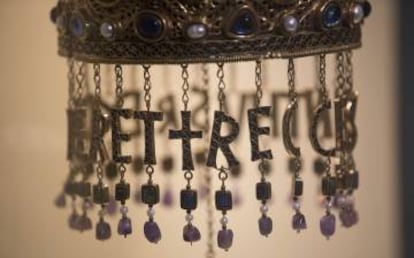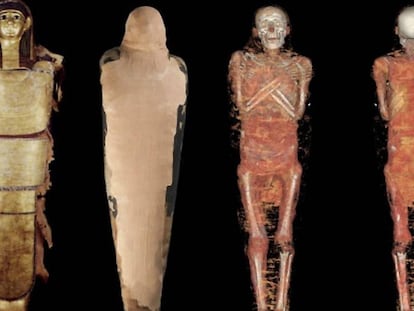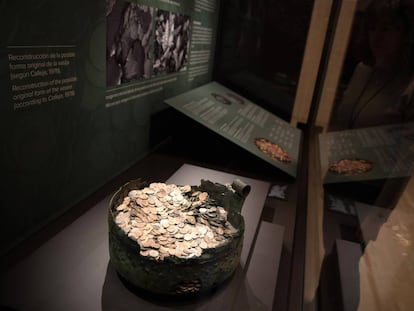The Guarrazar Treasure: a Visigoth mystery solved after 150 years
An archeologist has revealed why numerous golden crowns and other jewels were buried in a field 15 kilometers outside Toledo


Spanish archeologist Juan Manuel Rojas has solved a mystery that has been puzzling experts for more than 150 years: namely, who hid the trove of 20-odd golden Visigoth crowns and goblets and gem-studded crosses in a deserted spot 15 kilometers from Toledo in the district of Guadamur, and why?
The story that the treasure had been hidden in a field made no sense
Archaeologist Juan Manuel Rojas
Known as the Treasure of Guarrazar, the story behind the buried jewels has all the elements of a thriller, including betrayal, theft, diplomatic intrigue and even Nazis, and begins back in 711 when Táriq Ibn Ziyad’s troops swept across the Spanish peninsula.
Once these troops had conquered the armies of Don Rodrigo in the Laguna de la Janda battle – also known as the battle of Guadalete – the Berber and Muslim soldiers marched unchallenged on the Visigoth capital of Toledo.
Until recently, it was believed that, in light of their advance, the Christians in Toledo took the snap decision to hide the royal treasure in a field until the danger had passed.

They opened two graves and buried the crowns, chalices, jewels and golden crosses beneath the bodies, and that is where they stayed for more than 1,100 years until Escolástica Morales, daughter of Francisco Morales and María Pérez, answered a call of nature on her return from Toledo in the summer of 1858. Hiding behind a pile of stones, she saw something shiny glinting at her. Naturally, she called her parents and together they dug out the treasure, which they washed in what they assumed was an ordinary well before loading it onto their donkey and continuing on their way – apparently through a terrible storm.
What they couldn’t know was that another local from Guadamur called Domingo de la Cruz had been watching from a distance and, once they had gone, hurried to the same spot and, after a fair bit of digging around, discovered another cavity of similar proportions where the other half of the treasure had been hidden.
But why had these jewels been hidden in a field apparently without any clues as to their location?

It is a mystery that has led to political and historical intrigue and filled the pages of two recent books: The Last Visigoth Treasure by historian José Calvo Poyato and Guarrazar, The Hidden Treasure by historian Pedro Antonio Alonso Revenga.
As Rojas explains, “the story that the treasure had been hidden in a field made no sense. So I started to dig around in the area that had already been excavated by Amador de los Rios in 1859. He had found various structures and architectural remains. But the field theory persisted. It was a question of seeing it from a global perspective.”
With the help of the Guadamur City Hall, Rojas embarked on an investigation that led to the establishment of an archeological site that the public can now visit.
During recent years, the walls of a building more than 30 meters long have been unearthed as well as a basilica, the remains of what appears to have been a palace, a Visigoth graveyard and even a guest house for pilgrims. Rojas’ research has led to the revelation that the place where the treasure was hidden was not a field at all but a religious complex not unlike the one at Lourdes, France, with its own healing water that sprung from the well where Morales cleaned the jewels. So, far from being buried in an ignominious field, the royal treasure had been hidden in a prestigious site whose own ceilings were decked with votive crowns.
When its occupants found out about the unstoppable advance of the Muslim and Berber forces, they sought somewhere to hide the jewels and decided on the graveyard. Raising two tombstones, they removed the bodies, buried the treasure, covered it with cloths and sand and put the corpses back on top. When Escolástica went to relieve herself at the spot more than 1,000 years later, she ducked behind what had once been the wall around the cemetery.
In 2014, during the excavation work on one of the bigger buildings, the mayor of Guadamur, Sagrario Gutiérrez, put a spade in the well and prodded around in search of the source of the water that filled it. This turned up one of the jewels that had fallen from one of the crowns when Morales had washed them there.
Himmler’s twist
The Guarrazar Treasure was sold in 1856 to a number of Toledo jewelers. Numerous pieces were dismantled in order to keep them from the authorities. Those that remained intact ended up in the hands of the diamond trader José Navarro who sold them to the Cluny Museum in France.
Who were the Visgoths?
The Visigoths were a Germanic tribe who created an empire in what is today France, Spain and Portugal after the collapse of the Roman empire in the fourth century, until the seventh century, when the Arabs invaded and occupied much of the region.
The Spanish government subsequently tried to retrieve them but Napoleon III would not cooperate, dodging the requests with a variety of excuses.
Eventually, in 1941, during the Nazi occupation of France, Nazi henchman Heinrich Himmler returned a good portion of the jewels to General Francisco Franco, as well as archeological pieces such as the Lady of Elche bust. Now, much of the treasure can be admired in the National Archeological Museum and the Royal Palace in Madrid, while others remain at the Cluny Museum.
“It’s a thrilling story but it’s not over yet,” says author José Calvo Poyato. “Domingo de la Cruz, the other person who found many of the jewels, felt overwhelmed by the pressure and gave a chunk of it to Isabel II, including the Suintila crown. That was kept in the Royal Palace until 1921 when it was stolen.”
Calvo says that, despite coming close, the police failed to find it. “So where is the crown of Suintila, the Visigoth who rid the Pensinsula of the Byzantines? This is another mystery that has yet to be solved. It is certainly a compelling tale, worthy of a lot of books,” he says.
A stroll through history
Guadamur is a small town in the province of Toledo that has a fabulously conserved castle and the Guarrazar Treasure. Thanks to a number of initiatives, the public now has access to what is considered the most important Visigoth treasure trove in Europe. On the one hand, the center exhibits reproductions of crowns, chalices and crosses dug up from the Guarrazar estate together with descriptions of the Visigoth’s reign and architectural pieces found by locals that have been donated to the authorities.
And nearby is the archeological dig with guided tours and archeological and environmental activities for children. Entry is €8 with discounts for the unemployed and free entry for children under the age of 10.
English version by Heather Galloway.
Tu suscripción se está usando en otro dispositivo
¿Quieres añadir otro usuario a tu suscripción?
Si continúas leyendo en este dispositivo, no se podrá leer en el otro.
FlechaTu suscripción se está usando en otro dispositivo y solo puedes acceder a EL PAÍS desde un dispositivo a la vez.
Si quieres compartir tu cuenta, cambia tu suscripción a la modalidad Premium, así podrás añadir otro usuario. Cada uno accederá con su propia cuenta de email, lo que os permitirá personalizar vuestra experiencia en EL PAÍS.
¿Tienes una suscripción de empresa? Accede aquí para contratar más cuentas.
En el caso de no saber quién está usando tu cuenta, te recomendamos cambiar tu contraseña aquí.
Si decides continuar compartiendo tu cuenta, este mensaje se mostrará en tu dispositivo y en el de la otra persona que está usando tu cuenta de forma indefinida, afectando a tu experiencia de lectura. Puedes consultar aquí los términos y condiciones de la suscripción digital.
More information
Archived In
Últimas noticias
From digital curfews to blocking apps: How technology experts protect their children online
Why the price of coffee has skyrocketed: from Brazilian plantations to specialty coffee houses
Confined to a Cuban hospital: When electricity is a matter of life or death
Pinochet’s victims grapple with José Antonio Kast’s rise in Chile
Most viewed
- Pablo Escobar’s hippos: A serious environmental problem, 40 years on
- Reinhard Genzel, Nobel laureate in physics: ‘One-minute videos will never give you the truth’
- Why we lost the habit of sleeping in two segments and how that changed our sense of time
- Charles Dubouloz, mountaineering star, retires at 36 with a farewell tour inspired by Walter Bonatti
- The Florida Keys tourist paradise is besieged by immigration agents: ‘We’ve never seen anything like this’










































